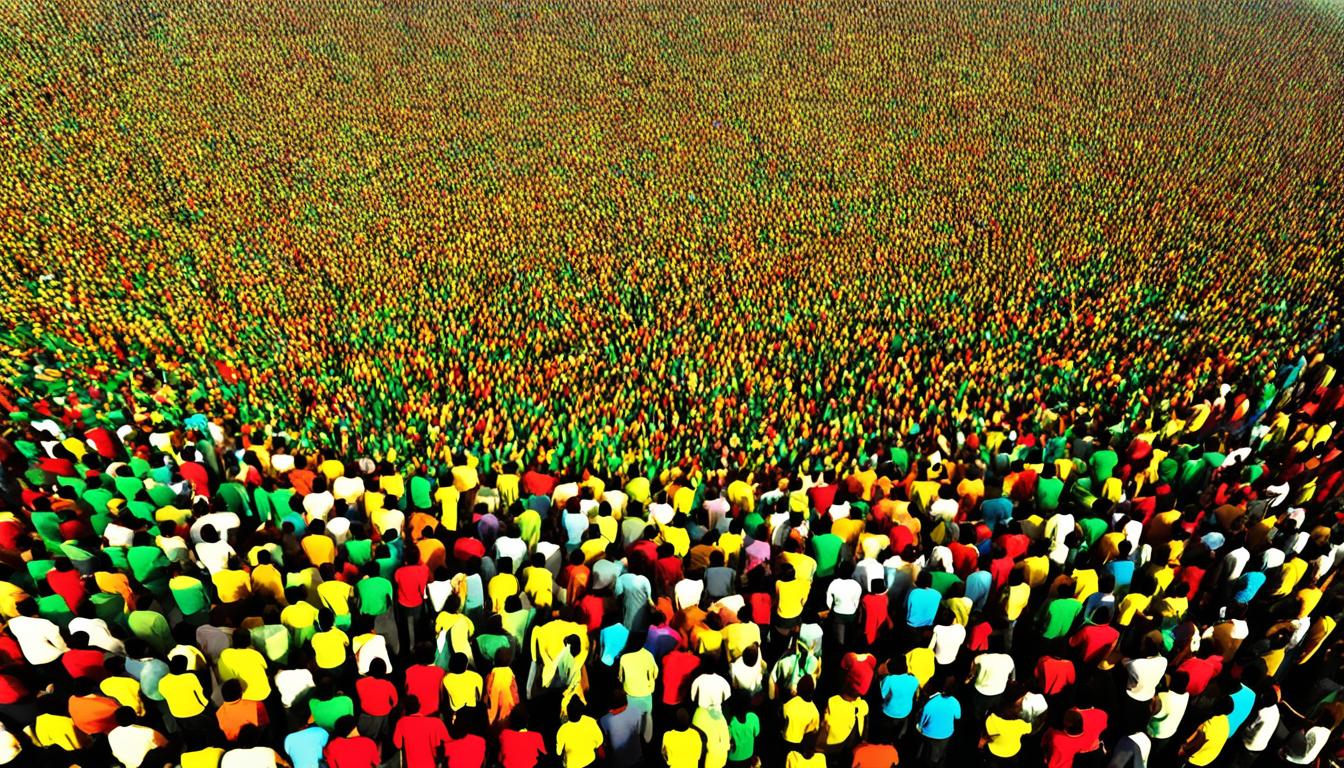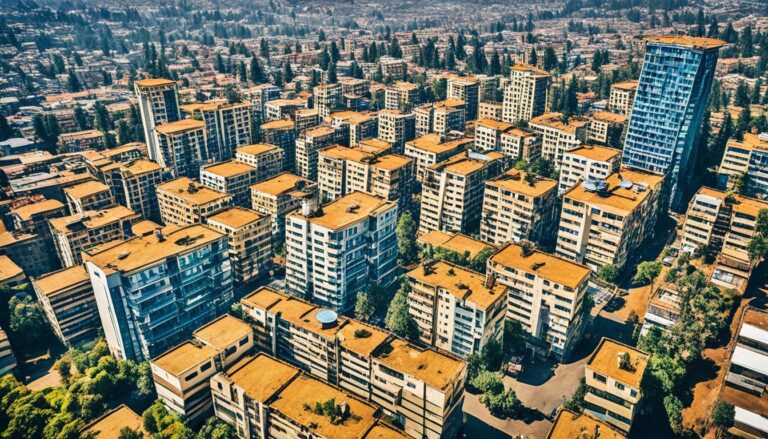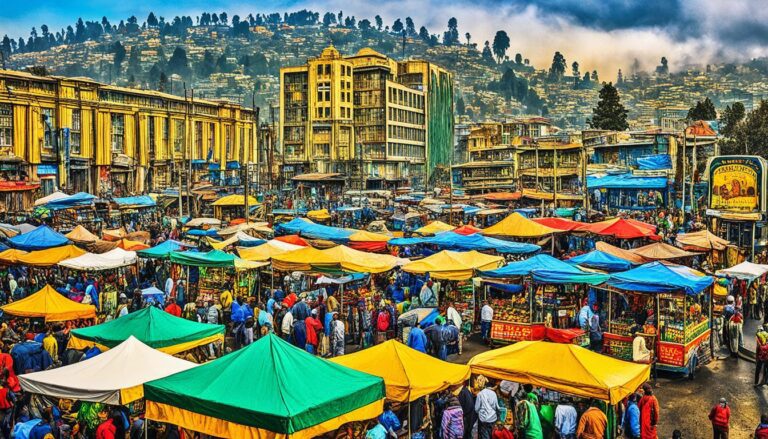How Many People Live in Ethiopia?
Did you know that Ethiopia, a country located in the Horn of Africa, is home to a staggering number of people? With a current population of 128,583,088 as of February 24, 2024, Ethiopia ranks as the second-most populous country in Africa. This fascinating statistic highlights the scale and impact of Ethiopia’s population, making it a topic worthy of exploration.
Key Takeaways:
- Ethiopia’s population is 128,583,088 as of February 24, 2024, making it the second-most populous country in Africa.
- Ethiopia’s population is equivalent to 1.57% of the total world population.
- The country has a population density of 127 per square kilometer.
- The median age in Ethiopia is 18.8 years.
- 22.1% of the population is urban, with Addis Ababa being the largest city.
Ethiopia Population Growth and Projections
As we explore the population dynamics of Ethiopia, it is crucial to examine the country’s growth and projections. Through analyzing population data and trends, we gain valuable insights into Ethiopia’s future development and societal changes.
The population of Ethiopia is projected to reach 129,719,719 in 2024, showing a steady increase from the current population of 128,583,088. With an estimated yearly growth rate of 2.52%, Ethiopia’s population is experiencing significant expansion and will continue to do so in the coming years. This growth can be attributed, in part, to the high fertility rate in the country, which stands at 3.88 children per woman.
In the future, the population of Ethiopia is expected to rise even further. By the year 2030, it is estimated that the population will reach 149,296,378. Looking ahead to 2050, projections indicate a population of 214,812,309. These figures emphasize the substantial population growth that Ethiopia will undergo, which is crucial to consider when planning for the country’s future development and resource allocation.
Ethiopia boasts a relatively young population, with a median age of 19.0 in 2024. This youthful demographic provides unique opportunities and challenges for the nation, with implications for various sectors such as education, healthcare, and employment. It also highlights the importance of investing in youth empowerment and ensuring their active participation in society.
“The population of Ethiopia is projected to reach 129,719,719 in 2024, with an estimated yearly growth rate of 2.52%.”
In addition to population size and age distribution, it is essential to examine the urbanization trend within Ethiopia. As of 2024, 22.5% of the population is living in urban areas, reflecting the country’s ongoing urbanization process. This shift from rural to urban living has significant implications for infrastructure development, resource management, and social dynamics within cities.
“Ethiopia has a relatively young population, with a median age of 19.0 in 2024.”
Ethiopia Population Growth and Projections (2024-2050)
| Year | Population |
|---|---|
| 2024 | 129,719,719 |
| 2030 | 149,296,378 |
| 2050 | 214,812,309 |
These population projections provide valuable insights into Ethiopia’s growth trajectory and serve as a framework for policymakers, researchers, and organizations to anticipate and address the country’s future needs and challenges.
Ethnic Groups and Languages in Ethiopia
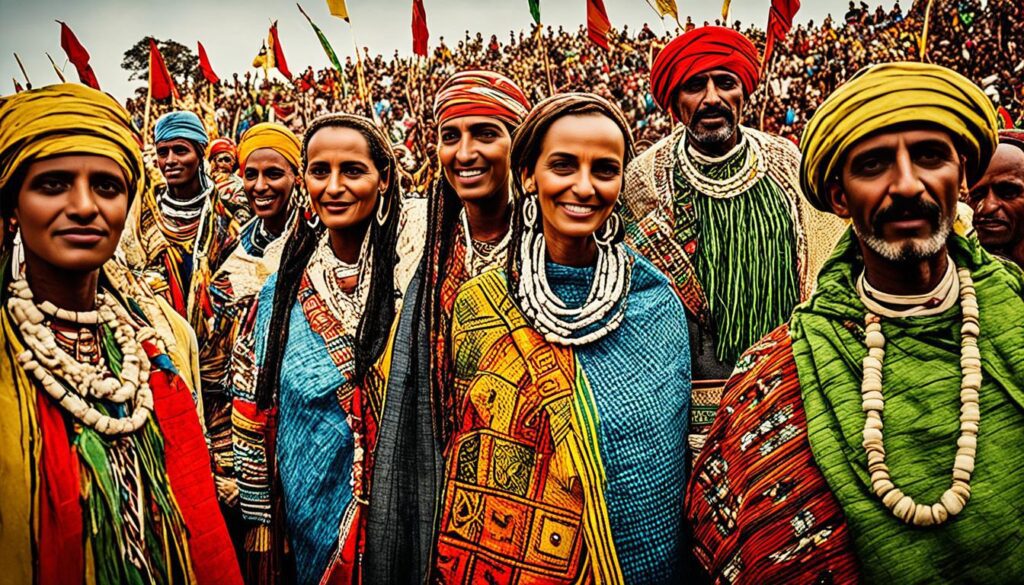
Ethiopia is a country known for its ethnic diversity, with over 80 different ethnic groups contributing to its vibrant cultural landscape. The largest ethnic group in Ethiopia is the Oromo, comprising 35.8% of the population, followed by the Amhara at 24.1%. Other significant ethnic groups include the Somali, Tigray, Sidama, Gurage, and Afar.
With such a diverse population, Ethiopia is also home to a variety of languages. The official national language is Amharic, spoken by 29.3% of the population. Amharic is widely used for administrative and governmental purposes. Additionally, there are several major regional languages spoken across the country.
“Language is the road map of a culture. It tells you where its people come from and where they are going.” – Rita Mae Brown
Some of the major languages spoken in Ethiopia include:
- Oromo: As the language of the largest ethnic group, it is widely spoken in many parts of Ethiopia.
- Somali: This language is predominantly spoken in the eastern regions of Ethiopia, bordering Somalia.
- Tigrinya: Primarily spoken in the northern part of the country, especially in the Tigray region.
- Sidama: Commonly spoken in the Southern Nations, Nationalities, and Peoples’ Region (SNNPR), particularly in the Sidama Zone.
The linguistic diversity in Ethiopia reflects the country’s rich heritage and highlights the importance of language preservation and cultural appreciation.
Whether through the celebration of diverse ethnic traditions or the promotion of multilingualism, Ethiopia embraces its cultural mosaic as a source of pride and strength.
Religion in Ethiopia
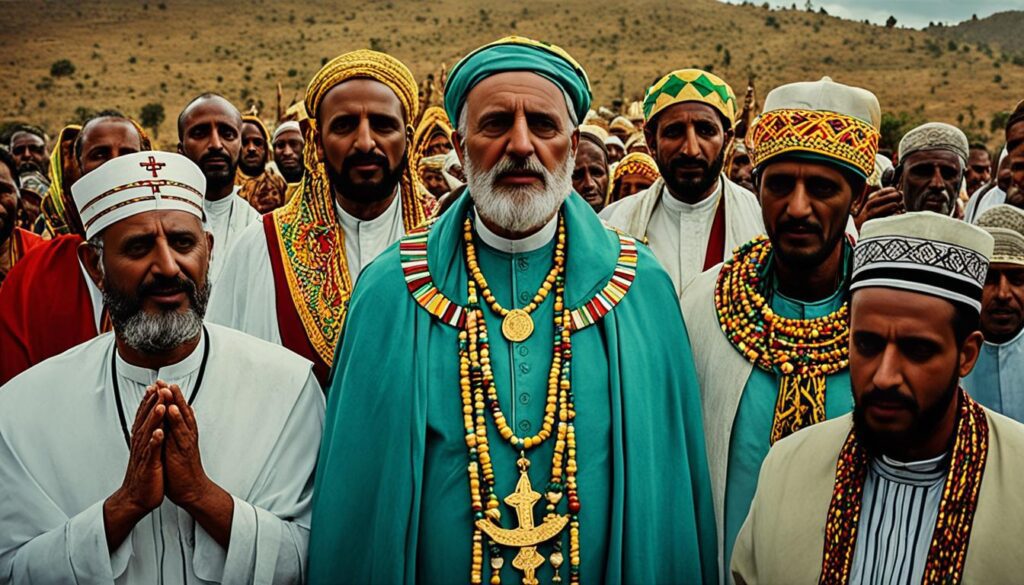
Ethiopia is a country with a rich religious heritage, characterized by the diversity of its religious practices. While Christianity is the most widely practiced religion, Islam also holds a significant place in the religious landscape of Ethiopia.
Christianity:
Christianity has a long history in Ethiopia, dating back to the 4th century AD. The Ethiopian Orthodox Church, also known as the Tewahedo Church, is the predominant Christian denomination in the country. It has a strong presence and influence over the people, culture, and traditions of Ethiopia. The Ethiopian Orthodox Church follows its own unique traditions and liturgical practices, which have evolved over centuries.
Islam:
Islam is the second-largest religion in Ethiopia, accounting for 31.3% of the population. The Islamic community in Ethiopia is diverse, consisting of different ethnic groups and sects. Muslims in Ethiopia follow both Sunni and Shia traditions. The practice of Islam in Ethiopia is deeply rooted in the history and culture of the country, with significant Muslim communities present in various regions.
In addition to Christianity and Islam, there are also small percentages of adherents to traditional faiths and other Christian denominations in Ethiopia.
Religion plays a significant role in shaping the social fabric and cultural identity of Ethiopia. It influences various aspects of life, including family values, social norms, and rituals. The coexistence of multiple religions in Ethiopia has contributed to the country’s cultural diversity and tolerance.
Overall, religion in Ethiopia is a reflection of its rich history and diverse population. The Ethiopian Orthodox Church and Islam are two major religious forces that coexist harmoniously, contributing to the cultural tapestry of the country.
Conclusion
In conclusion, Ethiopia is home to a diverse population of over 128 million people, making it the second-most populous country in Africa. With the Oromo and Amhara being the largest ethnic groups, Ethiopia exhibits a rich cultural tapestry. The country’s young population, with a median age of 18.8 years, suggests a promising future.
Looking ahead, the population is projected to continue growing in the coming years. Ethiopia’s reputation for religious diversity is evident through the prevalence of Christianity and Islam as the major religions. The Ethiopian Orthodox Church holds significant cultural and religious value.
Despite its population size, Ethiopia faces several challenges, including poverty, healthcare, and education. While progress has been made, there is still work to be done to improve the well-being of its people. It is important to acknowledge the resilience and potential of Ethiopia, and to support efforts that lead to positive change.

